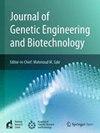Biosynthesis, characterization, antibacterial, antibiofilm, and antioxidant activities of sodium nanoparticles from Escherichia coli metabolites
IF 2.8
Q3 Biochemistry, Genetics and Molecular Biology
Journal of Genetic Engineering and Biotechnology
Pub Date : 2025-09-18
DOI:10.1016/j.jgeb.2025.100575
引用次数: 0
Abstract
This study emphasizes the need for strategies to tackle multi-drug resistant pathogens by investigating the antibacterial, antibiofilm, and antioxidant properties of sodium nanoparticles (NaNPs) derived from metabolites of Escherichia coli. The configuration of the NaNPs was examined through X-ray diffraction (XRD), Transmission electron microscopy (TEM), Fourier transform infrared spectroscopy (FTIR), Photoluminescence (PL), and Ultraviolet–visible spectroscopy (UV–Vis). XRD and TEM analyses revealed that NaNPs possess a grain size around 125 nm, exhibiting a crystallinity of 63.45 % and a rod-shaped morphology. The UV–Vis revealed considerable absorbance at 280 nm, leading to an optical bandgap of 4.125 eV. To evaluate antibacterial and antibiofilm characteristics, clinical bacteria including Streptococcus pneumonia, Enterococcus faecium, Klebsiella pneumonia, and Salmonella Typhimurium were identified and examined for multidrug resistance using antibiogram testing. The antibacterial activity was assessed through agar well diffusion, minimum inhibitory and bactericidal concentrations (MIC and MBC) tests, and a time-kill assay. The antibiofilm effect was assessed by preventing biofilm formation and removing established biofilm assays. The antioxidant potential was assessed through the 2,2-diphenyl-1-picrylhydrazyl (DPPH) radical scavenging assay. Antibacterial results demonstrated a bactericidal effect on Enterococcus faecium and Salmonella Typhimurium (MBCs 0.0625 and 0.125 mg/mL, respectively). Inhibition zones ranged from 7.3 to 10.5 mm. NaNPs inhibited bacterial growth following 5 h of incubation. Antibiofilm results revealed an inhibitory effect on biofilm development (with an inhibition percentage of 62 %) and a minimal impact on biofilm elimination (showing a destruction percentage of 21 %). Antioxidant results showed a significant scavenging effect, with the percentage of radical scavenging reaching 23 %. The results suggest positive effects of the NaNPs in biomedical applications.
大肠杆菌代谢物中纳米钠的生物合成、表征、抗菌、抗生物膜和抗氧化活性
本研究强调需要通过研究大肠杆菌代谢物衍生的纳米钠(NaNPs)的抗菌、抗生物膜和抗氧化特性来解决多重耐药病原体的策略。通过x射线衍射(XRD)、透射电子显微镜(TEM)、傅里叶变换红外光谱(FTIR)、光致发光(PL)和紫外可见光谱(UV-Vis)对纳米粒子的结构进行了表征。XRD和TEM分析表明,纳米粒子的晶粒尺寸约为125 nm,结晶度为63.45%,呈棒状。紫外可见光谱在280 nm处显示出相当大的吸光度,导致光学带隙为4.125 eV。为了评估抗菌和抗生物膜特性,临床细菌包括肺炎链球菌、屎肠球菌、肺炎克雷伯菌和鼠伤寒沙门菌,并通过抗生素谱检测检测其多药耐药性。通过琼脂孔扩散、最低抑菌和杀菌浓度(MIC和MBC)试验以及时间杀伤试验来评估抗菌活性。通过防止生物膜形成和去除已形成的生物膜试验来评估抗菌效果。通过2,2-二苯基-1-苦味酰肼(DPPH)自由基清除试验评估其抗氧化能力。对粪肠球菌和鼠伤寒沙门菌(MBCs分别为0.0625 mg/mL和0.125 mg/mL)均有抑菌作用。抑制区范围7.3 ~ 10.5 mm。培养5小时后,NaNPs抑制细菌生长。抗菌膜结果显示对生物膜发育有抑制作用(抑制率为62%),对生物膜消除的影响最小(破坏率为21%)。抗氧化效果明显,自由基清除率达23%。结果表明纳米粒子在生物医学应用中具有积极的作用。
本文章由计算机程序翻译,如有差异,请以英文原文为准。
求助全文
约1分钟内获得全文
求助全文
来源期刊

Journal of Genetic Engineering and Biotechnology
Biochemistry, Genetics and Molecular Biology-Biotechnology
CiteScore
5.70
自引率
5.70%
发文量
159
审稿时长
16 weeks
期刊介绍:
Journal of genetic engineering and biotechnology is devoted to rapid publication of full-length research papers that leads to significant contribution in advancing knowledge in genetic engineering and biotechnology and provide novel perspectives in this research area. JGEB includes all major themes related to genetic engineering and recombinant DNA. The area of interest of JGEB includes but not restricted to: •Plant genetics •Animal genetics •Bacterial enzymes •Agricultural Biotechnology, •Biochemistry, •Biophysics, •Bioinformatics, •Environmental Biotechnology, •Industrial Biotechnology, •Microbial biotechnology, •Medical Biotechnology, •Bioenergy, Biosafety, •Biosecurity, •Bioethics, •GMOS, •Genomic, •Proteomic JGEB accepts
 求助内容:
求助内容: 应助结果提醒方式:
应助结果提醒方式:


